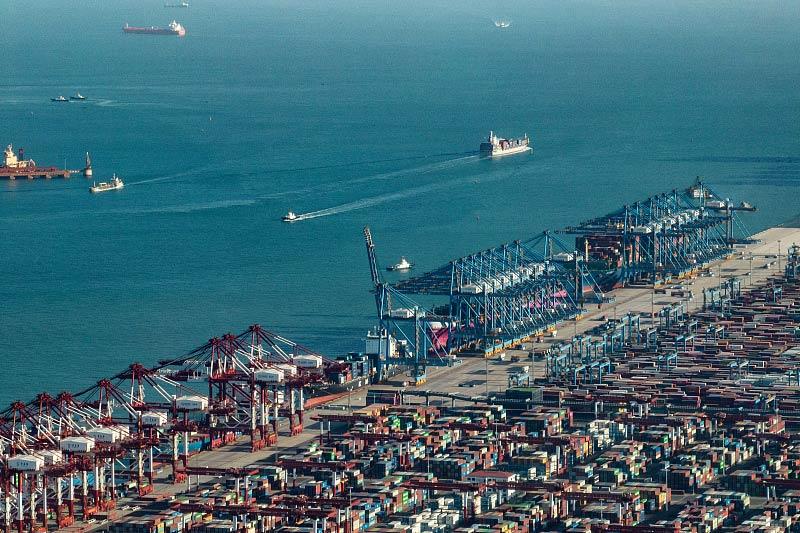12 Mar 2024 - {{hitsCtrl.values.hits}}

Morning view of the Lujiazui area in Pudong of Shanghai, east China, June 21, 2018. /Xinhua
Editor's note: Elias Jabbour, a special commentator on current affairs for CGTN, is an associate professor at the School of Economics at the State University of Rio de Janeiro. The article reflects the author's opinion, and not necessarily the views of CGTN.
There is a real gap between what we read in Western press and academic journals about the current state of the Chinese economy and the reality itself. For those who live in the countries of the Global North, China seems to be experiencing a major crisis that in itself signifies the first signs of exhaustion of its "model." For them, this is a "lesson": China should emphasize more on the role of consumption to replace an outdated model based on exports and investments.
But in reality, what we saw was an economic growth of 5.2 percent. Meanwhile, the United States saw 2.5 percent growth, Japan 1.9 percent, and France 0.9 percent, while the United Kingdom and Germany experienced negative growth of -0.1 percent. In terms of labor productivity, China's growth was 4.8 percent in 2023 while the United States suffered negative growth of -0.7 percent and Germany, -0.3 percent. In general terms, this means that China continues in the process of catching up with the major capitalist economies, in addition to already having full technological autonomy in several cutting-edge sectors.
What's most interesting is to note that China's economic performance has, since 2020, been at levels higher than necessary to meet the goals set for 2035. In other words, China should be able to reach a level of development desired by the country's leadership even before the projected time. Therefore, one has to ask the question why China has been successful not only in maintaining necessary growth levels, for example, to generate 11 million urban jobs projected for the 14th Five-Year Plan, but also in staying a main source of prosperity for the rest of the world, especially the countries of the Global South.
For example, in September 2013, Chinese President Xi Jinping launched what was then called the "Silk Road Economic Belt," currently the "Belt and Road Initiative" (BRI). Since then, 154 countries have formally joined the initiative with about $1 trillion invested in almost all continents of the world.
In other words, reality does not show a "Chernobyl moment" for the Chinese economy. There is an exaggerated emphasis on the problems that have arisen in China's real estate sector. It is clear that a near-sudden crisis in a sector responsible for around 30 percent of the economy of a country the size of China is not trivial, just as no capitalist country in the world is capable of planning a transition in the dynamics that involves a gigantic change between economic sectors and property regimes that would carry forward the Chinese project.

The Qianwan container terminal of Qingdao Port in east China's Shandong Province, December 14, 2022. /CFP
An example of this transition is the increase of credit to the industrial sector, notably those related to high technology in proportion to the reduction in bank resources dedicated to the real estate sector. Data from the People's Bank of China show that in the first three quarters of 2018, credit to the construction sector grew by 24.9 percent, while the growth of industrial credit reached around 5 percent. This trend has been changing since then. In the third quarter of 2023, the industrial sector saw credit access growth of 34.2 percent; for the real estate sector, the number was just 4.8 percent. What is implicit in these data is the concentration of energies on building China's full technological sovereignty faced with commercial and technological bullying from the United States.
This transition, despite being difficult given the magnitude of its operation, accelerates the construction of a high-quality development dynamic, as it implies the expansion of public services such as high-speed trains, heavy investments aimed at keeping China at the forefront of the current industrial revolution based on renewable energy industries, and a process of urbanization guided by the increase of people's access to new rights and new infrastructure such as modern hospitals, schools, inclusive and intelligent cities, etc.
The combination of all these new driving forces of economic growth will be the basis for what President Xi Jinping has called "new quality productive forces," that is, the emergence of a type of economic development based on very new technologies in all areas of social activity. In this sense, many interested in the future of Chinese development would ask: Is it possible to maintain growth rates compatible with the country's needs? For example, the target of 5 percent growth for 2024 was announced at the opening of the "Two Sessions" by Premier Li Qiang.
The answer is yes. It's not a matter of pure optimism about the future of the Chinese economy, but rather a particular view of those who have been following the development over the past decades of a large state and institutional machine, capable of directing the economy in a way to foresee contradictions and anticipate them with institutional innovations quickly and sufficiently.
The advantages that China counts on to achieve its growth and employment goals are generally overlooked in the West: 1) A large productive and financial core of a public nature centered on 96 large state-owned enterprises and 144 public financial institutions aimed at fostering development; and 2) The inauguration of new and superior forms of economic planning based on the broad use of disruptive tech innovations such as big data, artificial intelligence and 5G.
That's why I believe that China can maintain its economic growth at levels compatible with the needs of the country, and indeed, the world. The year 2024 will be marked by the consolidation of a development dynamic based on the "new quality productive forces."
(If you want to contribute and have specific expertise, please contact us at [email protected]. Follow @thouse_opinions on Twitter to discover the latest commentaries in the CGTN Opinion Section.)
Excerpt
29 Nov 2024 8 hours ago
29 Nov 2024 9 hours ago
29 Nov 2024 29 Nov 2024
29 Nov 2024 29 Nov 2024
29 Nov 2024 29 Nov 2024